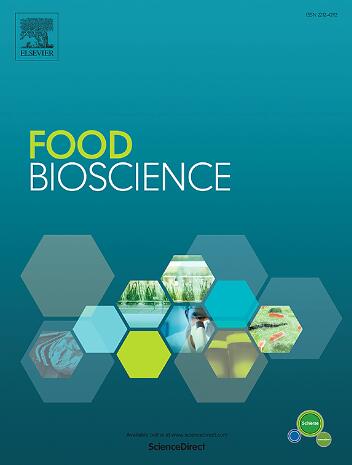Tyrosinase inhibition and enzyme kinetics of red rice bran protein peptides: Mechanism, identification, in silico exploration, and experimental validation
IF 4.8
1区 农林科学
Q1 FOOD SCIENCE & TECHNOLOGY
引用次数: 0
Abstract
Red rice (Oryza sativa L.) was recorded to have anti-melanogenic activity, but its active compounds were unknown. This study was intended to evaluate the tyrosinase inhibitory capacity of rice bran protein (RRBP) hydrolysates and obtain a novel tyrosinase-inhibitory peptide. RRBP was extracted with 0.2% alkali solution and hydrolyzed with alcalase (RRBP-A), pancreatin (RRBP-P), neutral (RRBP-N) and papain (RRBP-M), respectively. The results demonstrated that RRBP-A hydrolysate showed highest DPPH and ABTS radical scavenging abilities, FRAP value, tyrosinase-inhibitory effect and copper chelating activity. A total of 449 peptides were identified from RRBP-A by LC-MS/MS analysis. After a multi-step virtual screening process, Trp-Phe-Gly (WFG), Trp-Trp-Ala (WWA), Leu-Cys-Trp (LCW), Phe-Leu-Pro (FLP) and Tyr-Phe-Pro (YFP) were screened from RRBP-A. Compared with other peptides, LCW had higher DPPH (IC50, 109.5 ± 6.36 μg/mL), ABTS radical scavenging ability (IC50, 28 ± 1.41 μg/mL), FRAP value (349.07 ± 6.51 μmol/L), tyrosinase-inhibitory activity (IC50, 153.5 ± 4.95 μg/mL), and copper chelating activity (IC50, 1245.3 ± 83.1 μg/mL). HPLC analysis further confirmed that LCW acted as tyrosinase inhibitor. Molecular docking studies showed that LCW could bind to tyrosinase protein via both Cu400 and Cu401 sites, and other tyrosinase active sites. Additionally, LCW had an effective inhibitory effect on melanin production in mouse melanoma cell line (B16-F10 cells) by suppressing tyrosinase activity. The enzyme kinetic results exhibited that LCW had a mixed-type inhibition of tyrosinase. These results demonstrated that LCW had great potential on tyrosinase inhibitory effect and melanin production, indicating that LCW might be served in skin health care.

求助全文
约1分钟内获得全文
求助全文
来源期刊

Food Bioscience
Biochemistry, Genetics and Molecular Biology-Biochemistry
CiteScore
6.40
自引率
5.80%
发文量
671
审稿时长
27 days
期刊介绍:
Food Bioscience is a peer-reviewed journal that aims to provide a forum for recent developments in the field of bio-related food research. The journal focuses on both fundamental and applied research worldwide, with special attention to ethnic and cultural aspects of food bioresearch.
 求助内容:
求助内容: 应助结果提醒方式:
应助结果提醒方式:


